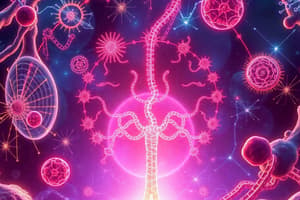Podcast
Questions and Answers
What is the initial reactant that combines with oxaloacetate to form citrate in the Krebs Cycle?
What is the initial reactant that combines with oxaloacetate to form citrate in the Krebs Cycle?
- Succinyl-CoA
- Acetyl-CoA (correct)
- Alpha-ketoglutarate
- Isocitrate
Which enzyme catalyzes the conversion of citrate to isocitrate in the Krebs Cycle?
Which enzyme catalyzes the conversion of citrate to isocitrate in the Krebs Cycle?
- Succinyl-CoA synthetase
- Aconitase (correct)
- Isocitrate dehydrogenase
- Citrate synthase
What is the byproduct of the reaction catalyzed by isocitrate dehydrogenase in the Krebs Cycle?
What is the byproduct of the reaction catalyzed by isocitrate dehydrogenase in the Krebs Cycle?
- FADH2
- ATP
- GTP
- NADH (correct)
What is the net energy yield of one turn of the Krebs Cycle in terms of ATP equivalents?
What is the net energy yield of one turn of the Krebs Cycle in terms of ATP equivalents?
Which step in the Krebs Cycle involves the hydration of fumarate to form malate?
Which step in the Krebs Cycle involves the hydration of fumarate to form malate?
What is the role of the Krebs Cycle in cellular respiration?
What is the role of the Krebs Cycle in cellular respiration?
Which molecule is regenerated at the end of the Krebs Cycle?
Which molecule is regenerated at the end of the Krebs Cycle?
Where does the Krebs Cycle take place in a eukaryotic cell?
Where does the Krebs Cycle take place in a eukaryotic cell?
What is the main difference between weather and climate?
What is the main difference between weather and climate?
Which of the following factors determines climate?
Which of the following factors determines climate?
What is the main purpose of a hygrometer?
What is the main purpose of a hygrometer?
Why is understanding weather and climate important?
Why is understanding weather and climate important?
What is an example of a tool used to study weather?
What is an example of a tool used to study weather?
What type of climate is characterized by high temperatures and high levels of humidity?
What type of climate is characterized by high temperatures and high levels of humidity?
Flashcards are hidden until you start studying
Study Notes
Krebs Cycle (Citric Acid Cycle or TCA Cycle)
- Critical metabolic pathway that generates energy through the oxidation of acetyl-CoA derived from carbohydrates, fats, and proteins.
- Occurs in the mitochondria of eukaryotic cells.
Overview of the Krebs Cycle
- Series of enzymatic reactions that play a central role in cellular respiration.
- Process by which cells harvest energy from organic molecules.
- Cycle begins with the condensation of acetyl-CoA with oxaloacetate to form citrate.
- Oxaloacetate is regenerated, enabling the cycle to continue.
Key Steps and Enzymes
- Formation of Citrate: Acetyl-CoA combines with oxaloacetate to form citrate, catalyzed by citrate synthase.
- Isomerization to Isocitrate: Citrate is converted to isocitrate via cis-aconitate intermediate, catalyzed by aconitase.
- Oxidative Decarboxylation: Isocitrate is oxidized and decarboxylated to alpha-ketoglutarate by isocitrate dehydrogenase, producing NADH.
- Formation of Succinyl-CoA: Alpha-ketoglutarate undergoes oxidative decarboxylation to form succinyl-CoA, catalyzed by alpha-ketoglutarate dehydrogenase, producing NADH.
- Conversion to Succinate: Succinyl-CoA is converted to succinate by succinyl-CoA synthetase, generating GTP (or ATP).
- Oxidation to Fumarate: Succinate is oxidized to fumarate by succinate dehydrogenase, producing FADH2.
- Hydration to Malate: Fumarate is hydrated to malate by fumarase.
- Regeneration of Oxaloacetate: Malate is oxidized to oxaloacetate by malate dehydrogenase, producing NADH.
Energy Yield
- Three molecules of NADH are produced per cycle.
- One molecule of FADH2 is produced per cycle.
- One molecule of GTP (or ATP) is produced per cycle.
- High-energy electron carriers (NADH and FADH2) proceed to the electron transport chain (ETC), where their energy is used to produce ATP through oxidative phosphorylation.
Regulation of the Krebs Cycle
- Tightly regulated by several factors.
- Substrate Availability: Availability of acetyl-CoA and oxaloacetate.
- Allosteric Enzymes: Key enzymes such as citrate synthase, isocitrate dehydrogenase, and alpha-ketoglutarate dehydrogenase are regulated by allosteric effects.
Weather and Climate
Weather
- Weather is the day-to-day condition of the atmosphere at a specific place and time.
- Weather can be described by:
- Temperature (hot or cold)
- Humidity (amount of water vapor in the air)
- Cloudiness (clear, cloudy, sunny)
- Wind direction and speed
- Precipitation (rain, snow, sleet, hail)
- Weather can change quickly, from day to day or even within a day.
Climate
- Climate refers to the long-term average atmospheric conditions in a specific region.
- Climate is determined by:
- Latitude (distance from the equator)
- Altitude (height above sea level)
- Proximity to large bodies of water
- Land use patterns
- Climate can be classified into different types, such as:
- Tropical
- Desert
- Temperate
- Polar
Differences between Weather and Climate
- Weather is short-term, while climate is long-term.
- Weather can change quickly, while climate changes slowly over time.
- Weather is local, while climate is regional or global.
Tools Used to Study Weather and Climate
- Thermometers measure temperature.
- Barometers measure air pressure.
- Hygrometers measure humidity.
- Anemometers measure wind speed and direction.
- Rain gauges measure precipitation.
- Weather vanes show wind direction.
Importance of Understanding Weather and Climate
- Helps prepare for and respond to natural disasters (e.g. hurricanes, droughts).
- Influences agriculture and food production.
- Affects human health and comfort.
- Impacts transportation and recreation activities.
Studying That Suits You
Use AI to generate personalized quizzes and flashcards to suit your learning preferences.




